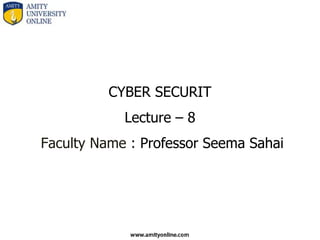Recommended
Recommended
More Related Content
What's hot
What's hot (6)
Implication of rh and qc on information security sharad nalawade(author)

Implication of rh and qc on information security sharad nalawade(author)
Similar to AMITY UNIVERSITY ONLINE
Similar to AMITY UNIVERSITY ONLINE (20)
Classical Encryption Techniques in Network Security

Classical Encryption Techniques in Network Security
Information and network security 11 cryptography and cryptanalysis

Information and network security 11 cryptography and cryptanalysis
information technology cryptography Msc chapter 1-4.pdf

information technology cryptography Msc chapter 1-4.pdf
Recently uploaded
This presentation was provided by William Mattingly of the Smithsonian Institution, during the fourth segment of the NISO training series "AI & Prompt Design." Session Four: Structured Data and Assistants, was held on April 25, 2024.Mattingly "AI & Prompt Design: Structured Data, Assistants, & RAG"

Mattingly "AI & Prompt Design: Structured Data, Assistants, & RAG"National Information Standards Organization (NISO)
Recently uploaded (20)
Beyond the EU: DORA and NIS 2 Directive's Global Impact

Beyond the EU: DORA and NIS 2 Directive's Global Impact
Disha NEET Physics Guide for classes 11 and 12.pdf

Disha NEET Physics Guide for classes 11 and 12.pdf
Measures of Dispersion and Variability: Range, QD, AD and SD

Measures of Dispersion and Variability: Range, QD, AD and SD
Measures of Central Tendency: Mean, Median and Mode

Measures of Central Tendency: Mean, Median and Mode
Ecosystem Interactions Class Discussion Presentation in Blue Green Lined Styl...

Ecosystem Interactions Class Discussion Presentation in Blue Green Lined Styl...
Mattingly "AI & Prompt Design: Structured Data, Assistants, & RAG"

Mattingly "AI & Prompt Design: Structured Data, Assistants, & RAG"
BAG TECHNIQUE Bag technique-a tool making use of public health bag through wh...

BAG TECHNIQUE Bag technique-a tool making use of public health bag through wh...
Call Girls in Dwarka Mor Delhi Contact Us 9654467111

Call Girls in Dwarka Mor Delhi Contact Us 9654467111
AMITY UNIVERSITY ONLINE
- 1. CYBER SECURIT Lecture – 8 Faculty Name : Professor Seema Sahai
- 2. Cryptography
- 3. Objectives • Describe the history of cryptography • Describe symmetric and asymmetric cryptography algorithms • Explain public key infrastructure (PKI) • Describe possible attacks on cryptosystems
- 4. Understanding Cryptography Basics • Cryptography is the process of converting plaintext into cipher text – Plaintext: readable text (also called clear text) – Cipher text: unreadable or encrypted text • Cryptography is used to hide information from unauthorized users • Decryption is the process of converting cipher text back to plaintext
- 5. History of Cryptography • Substitution cipher – Replaces one letter with another letter based on a key – Example: Julius Caesar’s Cipher • Used a key value of 3 • ABCDEFGHIJKLMNOPQRSTUVWXYZ • DEFGHIJKLMNOPQRSTUVWXYZABC
- 6. History of Cryptography (continued) • Cryptanalysis studies the process of breaking encryption algorithms • When a new encryption algorithm is developed, cryptanalysts study it and try to break it – Or prove that it is impractical to break it (taking much time and many resources)
- 7. Enigma • Used by the Germans during World War II – Replaced letters as they were typed – Substitutions were computed using a key and a set of switches or rotors – Image from Wikipedia
- 8. Steganography • The process of hiding data in plain view in pictures, graphics, or text – Example: changing colors slightly to encode individual bits in an image • The image on the left contains the image on the right hidden in it
- 9. Algorithms • An algorithm is a mathematical function or program that works with a key • Security comes from – A strong algorithm—one that cannot be reversed without the key – A key that cannot be found or guessed
- 10. Keys (not in textbook) • A sequence of random bits – The range of allowable values is called a key space • The larger the keys pace, the more secure the key – 8-bit key has 28 = 256 values in keys pace – 24-bit key has 224 = 16 million values – 56-bit key has 256 = 7 x 1016 values – 128-bit key has 2128 = 3 x 1038 values

